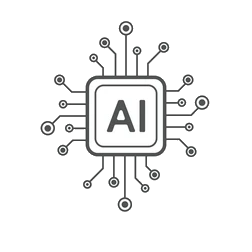AI & Machine Learning
Unlock the power of data with AI & Machine Learning skills.
Hands-on projects, real datasets, and expert mentorship.

Artificial Intelligence (AI) and Machine Learning (ML) are among the most in-demand technologies shaping the future. This course introduces you to the fundamentals, algorithms, tools, and real-world applications of AI & ML, equipping learners to build intelligent systems, work on predictive models, and explore roles like Machine Learning Engineer, Data Scientist, AI Developer, or NLP Engineer.


โ Prior basic knowledge of Python or programming is highly recommended
โ Comfort with math concepts (linear algebra, probability, calculus) helps
โ AI/ML needs practice with real data — not just theory
โ Start with CSV datasets and move to real-world problems
โ Use platforms like Kaggle, GitHub, and Google Colab for hands-on
โ Tools used: Python, Jupyter, Pandas, Scikit-learn, TensorFlow, OpenCV, NLTK
| Certification | Provider |
|---|---|
| AI for Everyone | Andrew Ng (Coursera) |
| Google AI / TensorFlow Certificate | |
| IBM AI & ML Professional Certificate | IBM via Coursera |
| Microsoft Azure AI Fundamentals (AI-900) | Microsoft |
| AWS Machine Learning Specialty | Amazon Web Services |
| Benefit | Description |
|---|---|
| ๐ง Foundation + Hands-On | Learn theory + real project implementation |
| ๐ผ High-Demand Careers | Entry into fields like AI, ML, Data Science, Robotics |
| ๐งฎ Industry Tools & Languages | Python, Scikit-learn, TensorFlow, Keras, OpenCV |
| ๐ Real Use Cases | Solve real-world problems: predictions, NLP, image processing |
| ๐ Certifications & Job Readiness | Prepare for interviews and online certifications |
| ๐๏ธ Capstone Projects | Build complete ML pipelines, chatbots, classifiers, etc. |
| ๐ Global Skillset | Future-proof career across industries like IT, finance, healthcare, and e-commerce |
Introduction to Artificial Intelligence & Machine Learning
Supervised, Unsupervised & Reinforcement Learning
Real-life applications in business, healthcare, finance, etc.
Libraries: NumPy, Pandas, Scikit-Learn
Regression, Classification, Clustering
Model evaluation, tuning, and deployment
Capstone project: Predictive ML model
Data wrangling, EDA (Exploratory Data Analysis)
Statistics for ML, Feature Engineering
Model building using ML algorithms
Real-world project with Jupyter Notebooks
Neural Networks, CNNs, RNNs, LSTM
Image classification, object detection
Text classification and NLP basics
Projects using TensorFlow 2.x and Keras
Text preprocessing, tokenization, stopwords removal
Sentiment analysis, Chatbots, Text classification
Tools: NLTK, spaCy, Hugging Face
Microsoft Azure AI Studio
Google AI/Vertex AI
IBM Watson
OpenAI API Introduction (ChatGPT, DALL·E)
AI for Process Automation
Use cases in HR, Retail, Finance, and IT
No-code & low-code AI tools
Model building to cloud deployment
Flask/Django + Heroku/AWS/GCP
GitHub, Streamlit dashboards
What is Artificial Intelligence?
What is Machine Learning vs. Deep Learning?
Real-world AI applications
Machine Learning lifecycle
Types of ML: Supervised, Unsupervised, Reinforcement
Python Basics (Data types, Loops, Functions)
Numpy and Pandas for Data Handling
Matplotlib and Seaborn for Visualization
Jupyter Notebook & Google Colab
Handling Missing Values, Outliers
Encoding Techniques (One-hot, Label encoding)
Feature Scaling: Normalization, Standardization
Train-Test Split & Data Pipelines
Linear & Logistic Regression
Decision Trees & Random Forests
K-Nearest Neighbors (KNN)
Support Vector Machines (SVM)
Model Evaluation (Accuracy, Confusion Matrix, ROC)
Clustering (K-Means, Hierarchical)
Dimensionality Reduction (PCA)
Association Rule Mining (Apriori)
Cross-Validation Techniques
Hyperparameter Tuning (Grid Search, Random Search)
Bias-Variance Tradeoff
Underfitting vs. Overfitting
Introduction to Deep Learning & ANN
Using TensorFlow and Keras
Building Neural Networks from Scratch
Activation Functions, Optimizers, Loss Functions
Image Processing with OpenCV
CNN (Convolutional Neural Networks)
Object Detection (YOLO, SSD basics)
Image Classification Projects
Text Preprocessing (Tokenization, Lemmatization)
Sentiment Analysis & Chatbot Basics
Word Embeddings (Word2Vec, GloVe)
Transformers & Introduction to LLMs (optional)
End-to-End ML Project (e.g., House Price Predictor, Spam Filter)
GitHub Portfolio Creation
Resume & LinkedIn Optimization
Interview Mock Practice
Certification Guidance (Google, IBM, Coursera)
What’s the difference between AI, ML, and Deep Learning?
How does a machine learn from data?
What is overfitting and how do you prevent it?
What’s the difference between classification and regression?
When would you use KNN vs. Logistic Regression?
What is the difference between apply() and map() in Pandas?
How do you handle missing values in a dataset?
What is the vanishing gradient problem?
Why use ReLU over Sigmoid?
What is the difference between stemming and lemmatization?
How do CNNs work for image classification?
| Track | Includes |
|---|---|
| AI Beginner Track | AI & ML Basics + Python + Mini Projects |
| Machine Learning Pro | ML with Python + EDA + Model Tuning + Git |
| Deep Learning Specialist | Neural Networks + TensorFlow + Projects |
| AI Engineer Career Path | ML + Deep Learning + NLP + Cloud Deployment |
| Data Science with AI Track | ML + Data Science + Visualizations + Real Projects |